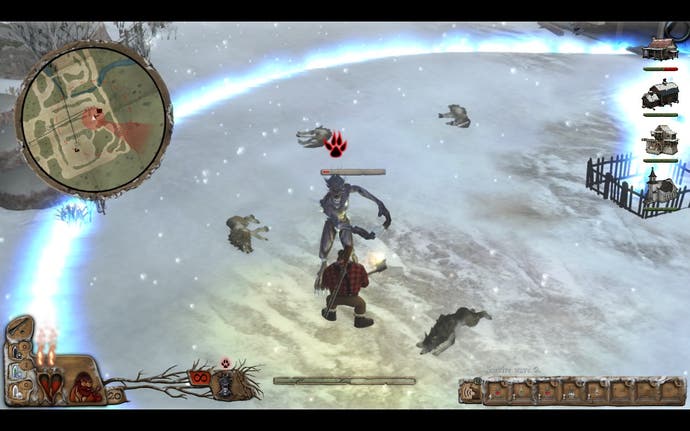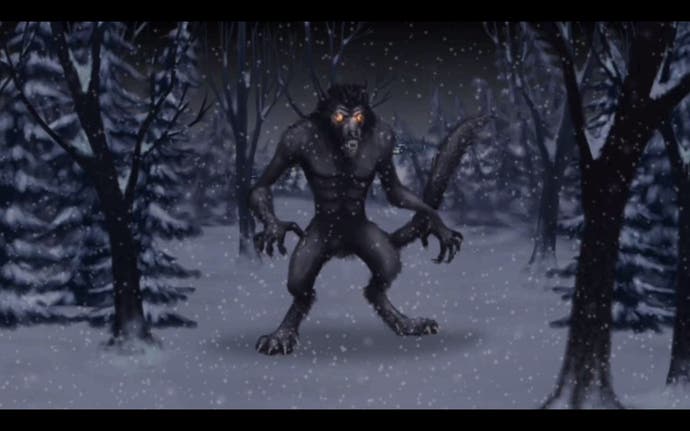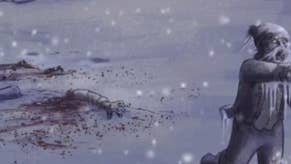After EA: How Sang-Froid's team left to head for the woods
Canadian Maikan.
Sang-Froid: Takes of Werewolves is a game about fighting wild animals - and it was inspired, in part, by one of its designer's experiences fighting wild animals. "I had just spent six months in Thailand," explains Vince Blanchard, the president of Artifice Studio. He's Skyping from the company offices - a kitchen in his friend's house in Montreal. "Long story short, I had to go through packs of dogs every time I wanted to get to my home."
While you could argue that any story that involves navigating packs of dogs doesn't really deserve to be cut short, this was far from the only element in the game's mix. Sang-Froid's a wonderfully strange blend of strategic tower-defence planning and real-time tactical combat. The clash of genres is fascinating, yet what's truly exciting about the whole thing is the way it allows international audiences a glimpse of a culture that generally doesn't get a look-in when video games are concerned. And I'm not talking about Thailand anymore.
Artifice Studio's debut is set in Quebec in 1858. You're cast as a local lumberjack who must protect your ailing sister from the machinations of the devil. Every day you stock up on supplies, chop wood to earn money, and place a series of traps around your cabin and the surrounding woods in preparation for the next onslaught from the forces of darkness. Every night, you take to the fields on foot and deal with wolves, werewolves, Maikan warriors and other miscellaneous ghouls face-to-face. Frosty, pine-laden and possessed of an unmistakable hardscrabble work ethic, it's a game that speaks volumes about the culture that produced it.

The core team at Artifice Studio mostly comes from EA Montreal, where they'd worked on series like the The Simpsons and Boogie and Army of Two. Polished but bland, the sparking, backwoods spirit of their debut game is nowhere to be seen in such a line-up. These games could have come from anywhere.
"It's quite paradoxical because in Montreal we make a lot of video games," explains Yan Pepin, the creative director. "We're really producing a lot of video games here. Almost none talks about our culture, though. It's not the same with our cinema industry, say. In Montreal we make a lot of movies. Even people from Hollywood come to Montreal to film their movies. But we also have a big culture of Québécois movies.
"That doesn't translate to games," he continues. "We wanted to change that fact. We wanted to improve that. We always thought that games could be used as a cultural product as much as entertainment. We think both can blend together - and they can even make each other better. We wanted to make a meaningful game. We wanted to make something that meant something to us. The games we were working on at EA, it was a great environment. We had the chance to work in a great studio, but at the same time..."
"We never had flexibility, we had restrictions," says Adam Rotondo, who handled everything from animation to elements of design on Sang-Froid. "We could never make what we wanted to make." Hence Artifice Studio? "From the beginning," Pepin smiles, "this was to be a game based on Québécois and Canadian folklore - and Indian folklore as well."
These local elements turned out to mesh surprisingly well with Blanchard's early concept: a game about dealing with deadly animals in which intimidating your prey with fire and the threat of violence - controlling their fear factor, to use the Artifice terminology - would be as important as just lashing out. (It's this emphasis on the AI that separates Sang-Froid from other genre mash-ups like Orcs Must Die.) "As soon as Yan came in, the whole thing started to become a bit more Canadian," laughs Blanchard. "Yan's the one who put it in Quebec in the 1800s. Suddenly you have a rifle, but it takes time to reload. Suddenly you have to play with bonfires."
"So we had this idea that the game which has a cultural side to it could be even better than the game without any cultural element," says Pepin. "We thought that by delving even deeper in the universe, this specific universe, could even help the gameplay. Vince mentions the gun, but we were even inspired by the AI, the different potions, some traps, or even parts of the environment. The forests in the game look a lot like the forests here in Quebec. We started with that idea, with the idea of being able to talk about something we knew."
This is seen most clearly in the game's enemies. These are Canadian werewolves you're tackling, beasts with a slightly different MO to the standard European and American strain. Canadian werewolves aren't poor unfortunates who have been bitten - they're poor unfortunates who have been corrupted by the devil, and whose souls have gone wandering the woods at night looking for wild animals to inhabit. Elsewhere, Windigos, a particularly terrifying ice monster that crop up in the later stages of Sang-Froid, are based on Native American mythology. They're cursed cannibals with an endless capacity for human flesh.

"Werewolves are kind of popular everywhere in international culture," laughs Pepin. "You can talk about werewolves to teenagers pretty much anywhere in the world. But we tend to know about werewolves a lot from the Hollywood point of view. Everywhere in French Canada - Manitoba, say, or Brunswick - there are lots of these more specific legends that came from a long, long time ago. Sometimes from France, sometimes from the Indians. Sometimes from England, even, and they were mixed together. Here in Quebec we have a pretty unique blend of all these different mythologies on werewolves. We thought, well, if you make a game of the Hollywood werewolves, we're at a disadvantage compared to American developers - it's their culture and they know about it more than we do. But if we make a game based on the way that our own ancestors saw werewolves a few hundred years ago, we're the absolute best specialists in the world. Nobody knows that better than us."
Is it a risk to make a game so culturally specific? The answer, in the case of Sang-Froid's success on PC, would seem to be no. After all, there's a subtle distinction at work here: Artifice wasn't making a game for a specific culture so much as it was making a game about a specific culture. It was opening a window so the rest of the world could peek in.
And the rest of the world seems pretty interested. "In August 2012, we had finished a version of the game and were getting ready to send it to Steam, but Steam told us it was too late and they were changing the way they selected games because Greenlight was coming," says Pepin. "That was very stressful and we didn't know where we were heading with that.
"We were then very surprised by the reaction from the community. We were in competition with around 700 games at the time. We knew we had a good game, but we didn't think we'd be popular enough to beat these more mainstream games. We were conscious that we were making a more niche, more hardcore game. We thought that might not be to our advantage. But we were wrong. We got a great response from around the world. We got selected. It was the best thing that happened to us for about three years."
So is there a positive lesson here about taking a gamble and giving audiences something truly distinct? "Yes!" says Pepin. "I think a lot of people take their inspirations for games from previous games. They think, I want to make a game like game A, with a mix of game B. I think that in fact in styling yourself with a specific culture is the best way to come up with really new ideas to make games. I hope that our game will help other people. Say you live in a village in India and you have a very specific culture. You make a game that reflects that, and when I buy it I get not only to have fun but to play a new game that's not just filled with orcs and dragons. I love that stuff, but it's inspired by European mythology. As much as I like that, there are stories and mythologies everywhere that can inspire great games."










.png?width=291&height=164&fit=crop&quality=80&format=jpg&auto=webp)
